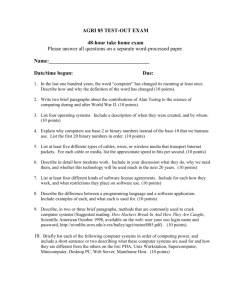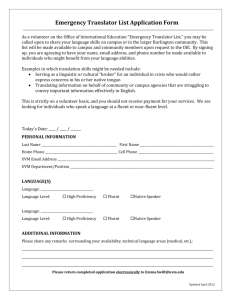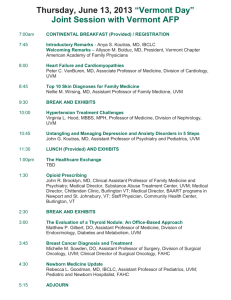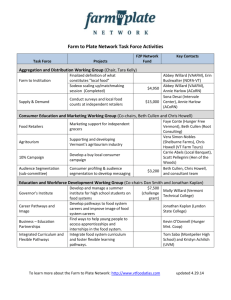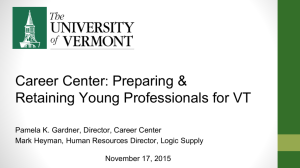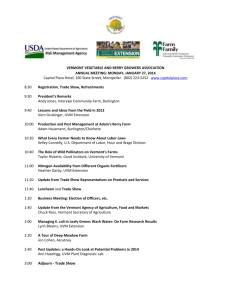Project Title: Farm to Freezer to Plate: Renewable Energy Cold
advertisement
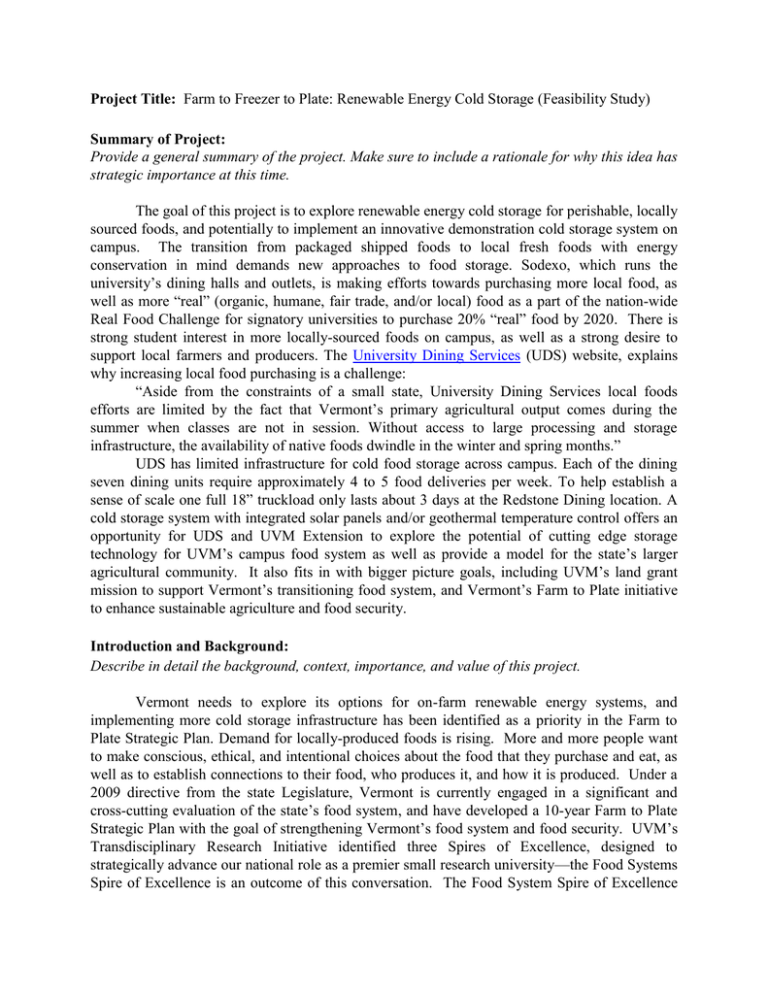
Project Title: Farm to Freezer to Plate: Renewable Energy Cold Storage (Feasibility Study) Summary of Project: Provide a general summary of the project. Make sure to include a rationale for why this idea has strategic importance at this time. The goal of this project is to explore renewable energy cold storage for perishable, locally sourced foods, and potentially to implement an innovative demonstration cold storage system on campus. The transition from packaged shipped foods to local fresh foods with energy conservation in mind demands new approaches to food storage. Sodexo, which runs the university’s dining halls and outlets, is making efforts towards purchasing more local food, as well as more “real” (organic, humane, fair trade, and/or local) food as a part of the nation-wide Real Food Challenge for signatory universities to purchase 20% “real” food by 2020. There is strong student interest in more locally-sourced foods on campus, as well as a strong desire to support local farmers and producers. The University Dining Services (UDS) website, explains why increasing local food purchasing is a challenge: “Aside from the constraints of a small state, University Dining Services local foods efforts are limited by the fact that Vermont’s primary agricultural output comes during the summer when classes are not in session. Without access to large processing and storage infrastructure, the availability of native foods dwindle in the winter and spring months.” UDS has limited infrastructure for cold food storage across campus. Each of the dining seven dining units require approximately 4 to 5 food deliveries per week. To help establish a sense of scale one full 18” truckload only lasts about 3 days at the Redstone Dining location. A cold storage system with integrated solar panels and/or geothermal temperature control offers an opportunity for UDS and UVM Extension to explore the potential of cutting edge storage technology for UVM’s campus food system as well as provide a model for the state’s larger agricultural community. It also fits in with bigger picture goals, including UVM’s land grant mission to support Vermont’s transitioning food system, and Vermont’s Farm to Plate initiative to enhance sustainable agriculture and food security. Introduction and Background: Describe in detail the background, context, importance, and value of this project. Vermont needs to explore its options for on-farm renewable energy systems, and implementing more cold storage infrastructure has been identified as a priority in the Farm to Plate Strategic Plan. Demand for locally-produced foods is rising. More and more people want to make conscious, ethical, and intentional choices about the food that they purchase and eat, as well as to establish connections to their food, who produces it, and how it is produced. Under a 2009 directive from the state Legislature, Vermont is currently engaged in a significant and cross-cutting evaluation of the state’s food system, and have developed a 10-year Farm to Plate Strategic Plan with the goal of strengthening Vermont’s food system and food security. UVM’s Transdisciplinary Research Initiative identified three Spires of Excellence, designed to strategically advance our national role as a premier small research university—the Food Systems Spire of Excellence is an outcome of this conversation. The Food System Spire of Excellence makes it an academic priority to give our University and its students the tools to tackle the complexity of 21st century food systems issues — in Vermont and around the world — including food production, climate change, nutrition and public health, food security, food safety, rural economic development, biofuels, and more. A new Food Systems master’s program trains students to offer solutions as we rethink the current labor and energy restrictions of our mainstream agricultural system. The Farm to Plate Strategic Plan identifies a key goal for the health of the state’s food system: implementing appropriate storage infrastructure to meet growing year-round consumer demand—within ten years. It also finds that Vermont has lost much of the knowledge and infrastructure necessary to store food for out-of-season use. Last year, recognizing the importance of renewable energy in out-of-season food production and research, the Clean Energy Fund funded two compost heat recovery projects. This proposal fits in with the goals and spirit of these projects by exploring new ways that the University can spearhead critical food systems research and infrastructure that increases Vermont’s food system health, resilience, and independence. The project will provide education, training, and research opportunities across UVM’s Food Systems spire, while working with diverse university and community partners to pilot a practical solution to UDS’ commitment to providing fresh, local food to campus yearround. Methodology and Timeframe: How will the idea be carried out? Which individuals and offices will be involved? How long will the project take to complete, and what is the timeframe for each key phase? Include information on long-term maintenance and accountability. A feasibility study is proposed to explore implementing a pilot renewable energy cold storage unit on campus, with the cooperation of Sodexo. Phase II of this project would be installing the cooling unit, powered by renewable energy systems like solar PV and/or ground source heat pumps—UVM is interested in exploring geothermal energy on campus. On campus, students from the undergraduate Food Systems program, and the Food Systems Master’s program, would be involved in the design and implementation of the feasibility study. A project like this could constitute a Master’s thesis or project for a Food Systems or CDAE Master’s student; this proposal embeds significant research questions around where in the food chain production and distribution chain cold storage is best positioned, as well as how institutions fit into this picture. Students from agriculture and life sciences, engineering, business, economics, and environmental programs could be involved in the research phase as well. The Horticulture Farm, Common Ground Student Farm, and the College of Agriculture and Life Sciences are also potential partners. Physical Plant and Facilities would be involved as well. The Intervale Food Hub, UVM Extension, and the Farm to Plate network are all interested in exploring and piloting cold storage projects, and would be partners and mentors in this work. The goal would be to complete the feasibility study in the space of an academic year. Phase I: Feasibility Study: Spring 2013 Phase II: Implementation, based on results of the Feasibility Study: Fall 2014 Benefits and Results: Describe the educational, environmental, and economic benefits this project will provide (for example, energy savings, return on investment, reductions in greenhouse gas emissions, learning opportunities and outcomes, or any other broader impacts on the university community). Determining ways to strengthen local food systems is a hot topic right now, especially in Vermont. Plus, student interest in the link between energy and food systems has been increasing as shown by the growth in related classes and clubs within the past few years. This would provide an opportunity for students to conduct meaningful research that could be applied beyond the borders of the university (for example, Vermont’s Farm to Plate Strategic Plan goal of reaching 10% local food in state by 2021). Local food travels less and produces less greenhouse gas emissions; and transportation is currently one of the largest contributors to UVM’s carbon footprint. Researching the possibility of storing, and therefore sourcing, more local food aligns UVM’s goal of reaching carbon neutrality by 2025. Upon the results of the feasibility study, Phase II would implement this innovative system, offering educational opportunities for students in disciplines ranging from agriculture to engineering to community development. It would also serve as a much-needed model for other institutions, as well as members of Vermont’s agricultural community. Investigating innovative ways to increase local food purchasing early is a step in the right direction to food security for our university, and by purchasing locally we also benefit and grow our local economy and community. Student Engagement: How, specifically, will this project provide opportunities for student engagement? There are many classes offered at the graduate and undergraduate level that could incorporate this research into their semester projects as a service-learning opportunity. An individual or individuals in any of the departments listed below (plus more) could conduct aspects of this feasibility study as a senior thesis or capstone project. The feasibility study itself could be a Food Systems or CDAE graduate thesis or project. An internship could be incorporated into the feasibility study as well. Nutrition and Food Systems NFS 73 - Farm to Food System - Susan Munkres NFS 153 - Principles of Food Technology - Todd Jay Pritchard NFS 250 - Food Service Systems - Sylvia Maria Geiger Food Systems FS 345 - Food Systems, Society & Policy - Amy Bell Trubek FS 340 - Food Systems, Science & Policy - Paul Stephen Kindstedt CDAE251/FS 395 - Research Methods - Jane Kolodinsky CDAE CDAE 250 - Applied Research Methods - David Conner CDAE 295 - Marketing Social Change: Food & Health - Andrea Lee Grayson CDAE 395 - The Economics of Food Systems - David S Conner Environmental Science ENSC 185 - Principals & Applications of Renewable Energy - Gary Flomenhoft ENSC 285 - Principals & Applications of Renewable Energy - Gary Flomenhoft Environmental Studies ENVS 195 - Vermont Food Systems ENVS 295 - Energy Use In Food Systems - Eric Garza ENVS 194 - Campus Sustainability - Gioa Thompson ENVS 195 - Vermont Energy Systems - Logan Brown Physics PHYS 009 - Energy and the Environment - Malcom Sanders Engineering EE 295 - Energy Systems Engineering - Walter John Varhue ME 195 - Building Energy Systems - William Louisos ME 195 - Global Renewable Energy - William Louisos Various student clubs and organizations on campus could also get involved: Eco-Reps VSTEP – Vermont Student Environmental Program SEEDS – Student Environmental Educators Doing Service Slade Gardening Cooperative Sprouting Possibilities (environmental education) Vermont Campus Energy Group Ecological Green Design Students IEEE AERO – International Electrical and Electronics Engineers Alternative Energy Racing Organization Real Food Working Group Dining Services Advisory Council Suggested Project Champion(s): Include the names, phone numbers, email addresses, roles, and departmental affiliations of individuals who may be interested in developing this idea into an implemented project. The individuals below have all expressed interest and strong support for this project in light of UVM and state food system goals: Kate Blofson- Office of Sustainability Graduate Fellow Phone: (802) 656-0895 Email: kblofson@uvm.edu Chris Callahan- UVM Extension Engineer and Assistant Professor of Agricultural Engineering Phone: (802) 773-3349 ext. 277 Email: Chris.callahan@uvm.edu Mark Cannella- UVM Extension Farm Business Management Specialist Phone: (802) 223-2389 Email: Mark.Cannella@uvm.edu Erica Campbell- Farm to Plate Program Director Phone: (802) 828-3745 Email: farm2plate@vsjf.org Eric DeLuca- National Cooperative Business Associate Program Manager Phone: (413) 854-3428 Email: edeluc@ncba.coop Sona Desai- Intervale Center Food Hub Manager Phone: (802) 660-0440 x112 Email: sona@intervale.org Jane Kolodinsky- UVM Food Systems Spire Steering Committee Chair Phone: (802) 656-4616 Email: jkolodin@uvm.edu Caylin McKee- University Dining Services/Sodexo Social Media & Sustainability Outreach Coordinator Phone: (802) 656-7911 Email: camckee@uvm.edu Brian Roper- University Dining Services/Sodexo Executive Chef Phone: (802) 656-8643 Email: brian.roper@uvm.edu Projected Budget and Budget Justification: Outline the project budget, justifying the need for all expenditures. Budgeting would be very different depending on who conducts the research. Because our goal is to have high student involvement, we expect to need minimal financial support in Phase I. ≤ $1,000 to support undergraduate student research as a thesis/project ≤ $1,000 to support undergraduate student research as a for-credit internship ~ $5,000 to fund a graduate student’s research ~ $5,000 to fund an undergraduate student research internship For Phase II—the implementation phase, pending study results—we would likely be pursuing a grant somewhere in the range of $10,000-$30,000. Project costs are expected to be no less than 1 million. Identifying additional funding sources would be necessary. Justification for use of student-supported- CEF Funds: Why is this project appropriate for the Clean Energy Fund, as opposed to another funding source? What complementary in-kind or monetary support does this project have? Students have a strong interest and stake in ensuring that their food on campus is procured locally. Stakeholders like Sodexo, Farm to Plate, UVM Food Systems Spire and UVM Extension among others are all interested in finding solutions to seasonality barriers Vermont (and UVM UDS) faces, so there are outside supporters of this effort that could include funding beyond a CEF contribution. CEF funding will ensure that this research is centered on renewable energy and student involvement. It is simple enough to add more cold storage to UVM’s kitchens but the goal of this research would be to determine the feasibility of increasing storage, and in turn local food purchasing, without increasing UVM’s carbon footprint.

